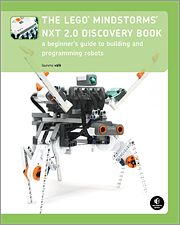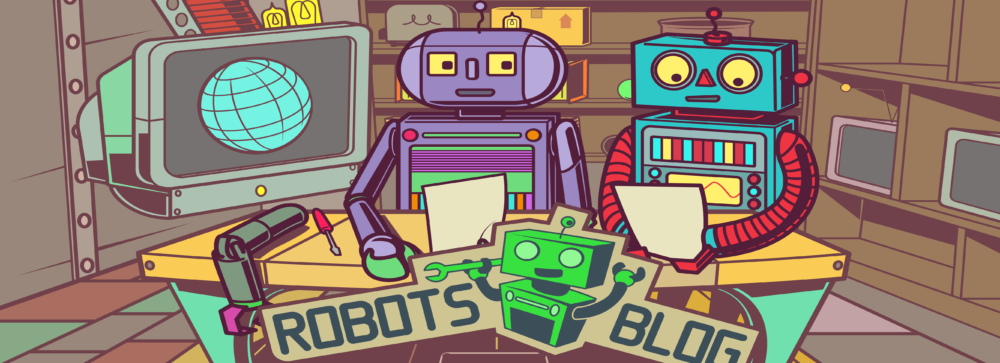Archiv der Kategorie: Development
Roberta Manual zum Entwickeln von Android Apps

Dieses Manual zeigt wie Apps für das Google Betriebssystem Android programmiert werden können und wie diese u. a. mit
dem LEGO Mindstorms NXT verbunden werden.
Die Entwicklung der Apps erfolgt mit dem App Inventor von Google. Eine Schritt-für-Schritt Anleitung mit vielen Screen-Shots erläutert ausführlich die grafische Programmierung der Android-Apps.
Inhaltsverzeichnis:
Impressum
Vorwort
Allgemeine Information
Warum App Inventor?
Was ist Google App Inventor?
Versuchsaufbau und vorbereitende Arbeiten
Meine Erste App
App zur Steuerung des NXT
Ausblick
Links und Literatur
Link zur Download-Seite: http://roberta-home.de/de/was-bietet-roberta/roberta-reihe/roberta-manual-zum-entwickeln-von-android-apps
Remote Controlled NXT via Android Phone
The guys at freedroidz developed an android app to remote control the Lego Mindstorms NXT. Here is a Youtube-Video showing the remote control in action:
The required Software is available for download at:
https://wiki.evolvis.org/freedroidz/index.php/Android_Remote_de
First Day of Safety, Security and Rescue Robots 2010 (SSRR-2010)
Currently I’m participating at the workshop of Safety, Security and Rescue Robots 2010 in Bremen.
The first day is now gone and a lot of interesting talks have been given:
Tetsuya Kinugasa has shown a Flexible Displacement Sensor in his talk of „Measurement of Flexed Posture for Mono-tread Mobile Track Using New Flexible Displacement Sensor„. His group develops and uses this sensor to control the posture of a robot which is a combination of snake, worm and tank.
Jimmy Tran presented his works on „Canine Assisted Robot Deployment for Urban Search and Rescue„. The basic idea is as simple as brilliant, use a equipped dog to find victims and to inform operators about him. So, dogs are well used in rescue and they have a high mobility. They can easily overcome huge rubles and are able to carry video cameras or rescue material. So, his approach is to use the dogs to deploy a small robot next to a victim, which would allow to investigate medical status of the person. The idea is hilarious.
„Development of leg-track hybrid locomotion to traverse loose slopes and irregular terrain“ is so far the most interesting technical approach of this workshop. It shows a way how a tracked like vehicle can be combined with a semi-Walker.
Donny Kurnia Sutantyo presented his work on „Multi-Robot Searching Algorithm Using Levy Flight and Artificial Potential Field„, while Julian de Hoog showed a solution for team exploration in „Dynamic Team Hierarchies in Communication-Limited Multi-Robot Exploration“.
The invited speaker Bernardo Wagner showed the outcomes of his department. The Leibniz University of Hannover has worked intensively in the field of „Perception and Navigation with 3D Laser Range Data in Challenging Environments„.
„Potential Field based Approach for Coordinate Exploration with a Multi-Robot Team“ is topic of Alessandro Renzaglia.
Bin Li showed another nice approach of a shape shifting robot. His robot is able to shape shift it self by rearranging its three motion segments. „Cooperative Reconfiguration between Two Specific Configurations for A Shape-shifting Robot“
Jorge Bruno Silva presented a approach of trajectory planing while respecting time constrains in „Generating Trajectories With Temporal Constraints for an Autonomous Robot“
Noritaka Sato closed the day by presenting novel a HMI approach for teleoperation. Instead of showing only the direct camera image his group uses temporal shifted images to generate an artificial bird eye view, like it is given in computer car games. „Teleoperation System Using Past Image Records Considering Moving Objects“
I am looking forward to listen to the next talks.
PR2 Robot Fetches Beer from the Refrigerator
The LEGO MINDSTORMS NXT 2.0 Discovery Book —New from No Starch Press

A Beginner’s Guide to LEGO MINDSTORMS NXT 2.0
San Francisco, CA, April 22, 2010—The LEGO® MINDSTORMS® NXT 2.0 set brings robot building to a wide range of hobbyists. But the NXT kit doesn’t come with a how-to guide and it only includes building instructions for four robots. Users new to building complex LEGO models or lacking experience with the NXT programming language need guidance to help them reach the next level. The LEGO MINDSTORMS NXT 2.0 Discovery Book is the introductory book that they’ve been waiting for.
In The LEGO MINDSTORMS NXT 2.0 Discovery Book (No Starch Press, May 2010, 320 pp., $29.95, ISBN 9781593272111), readers learn how to harness the capabilities of the NXT 2.0 set to build and program their own robots. Author Laurens Valk begins by walking readers through the set, describing the pieces and explaining how to get started with the software used to program NXT robots. Once readers understand the basics of the NXT programming language, the book’s tutorials show them how to build robots that move, monitor sensors, and use advanced programming techniques like data wires and variables. With crystal clear, step-by-step instructions, readers will find it easy to create working robots in no time. The LEGO MINDSTORMS NXT 2.0 Discovery Book features:
- A complete introduction to LEGO MINDSTORMS NXT 2.0
- Building and programming instructions for eight innovative robots, including a robotic defense system, a six-legged walker, and an autonomous robotic arm
- 50 sample programs and 72 programming challenges (ranging from easy to hard) that encourage readers to explore newly learned programming skills
- 15 building challenges that expand on the robot designs to help readers develop ideas for new robots
All of the robots in the book require just one NXT 2.0 set to build; there are no extra pieces required.
„The NXT set can be complicated. Sure, you can build some sort of robot, but can you actually make it do anything interesting?“ said No Starch Press founder Bill Pollock. „This is the introductory MINDSTORMS 2.0 book that everyone needs; the one book that will make sure that that pricey MINDSTORMS kit won’t end up gathering dust in a shoebox somewhere.“
Table of Contents
Chapter 1: Collecting the Equipment for Your Robot
Chapter 2: Building Your First Robot
Chapter 3: Creating and Modifying Programs
Chapter 4: Working with Programming Blocks: Move, Sound, and Display
Chapter 5: Waiting, Repeating and Other Programming Techniques
Chapter 6: Understanding Sensors
Chapter 7: Using the Touch, Color, and Rotation Sensors
Chapter 8: Shot-Roller: A Robotic Defense System
Chapter 9: Strider: The Six-Legged Walking Creature
Chapter 10: Using Data Hubs and Data Wires
Chapter 11: Using Data Blocks and Using Data Wires with Loops and Switches
Chapter 12: Using Variables, Constants, and Playing Games on the NXT
Chapter 13: Snatcher: The Autonomous Robotic Arm
Chapter 14: Hybrid Brick Sorter: Sort Bricks by Color and Size
Chapter 15: CCC: The Compact Chimney Climber
Appendix: Transferring Programs to the NXT with USB or Bluetooth
About the Author
Laurens Valk is a member of the MINDSTORMS Community Partners who help test and develop new NXT products. He has been inventing robots with the MINDSTORMS NXT sets since their introduction, and one of his robot designs appears on the NXT 2.0 packaging. Valk is a co-author of LEGO MINDSTORMS NXT One-Kit Wonders (No Starch Press) and a contributor to The NXT Step Blog. He lives in the Netherlands where he teaches robotics.
K-Dimensional space-partitioning data structure library for C++
On of the most common question by handling large data sets is „How to represented the data?“ and of course the answer is versatile. One of the most used solution is a tree like structure, organized by at least one sorting criteria.
KDTree++ is a c++ library which is supporting this feature. KDTrees are allowing to sort data by ‚k‘-Dimensional sorting criteria and the library implements a template based realization. KDTree++ is published under Artistic License 2.0.
Update: I was trying to use KDTree++ in on of our projects on Three-Dimensional perception and Point Clouds analysis. Therefore i was adding roundabout 30.000 Points (x,y,z-coordinates plus some extra informations) into such a tree. The first feeling was quiet positive. It was fast and did not consume that much resources. But by using the search functionality, provided by KDTree++ i was shocked. Every time i was placing a query the memory consumption did rise up dramatically, and even worse, it was staying that high. After investigating the KDTree code i figured out that the library does on each query create a copy of the found items and returns them. Unfortunately those items are never deleted and if i try to deleted them by my self the library produces a segmentation fault. So, summing up i would say that these library is really powerful, but bad documented and seems to have some serious bugs.
Jeffrey
Roberta has a new companion, called Jeffrey. Jeffrey is able to find his dockingstation to recharge his battery. Here are some videos of Jeffrey, found on the Roberta Youtube Channel
FAIR Libary is online
As we have already reported is the „Fraunhofer Autonomous Intelligent Robotics Devices“ Library now open source and available at the sourceforge project „OpenVolksBot„. In addition we can know report some more details on it.
- The FAIRlib is now organized as several Eclipse-Project (fairAlgorithm, fairCore, fairDevices, fairGraphics, fairTestAlgorithm, fairTestCore, fairTestDevices and fairTestGraphics). This allows an easy extending and compiling the projects and minimizes the cross dependencies.
- The dependences are listed in the ReadMe and can be auto installed by using the script „apt-get-fair“
- A way of easy installing is given by the script „install-fair„
- The current version is tested on the Ubuntu 9.10 (64-Bit) , but will also work on other OS (by side of auto solving the dependences)
- Fair is published under the CC-by-sa-nc License .
So now we all can reuse and cooperated in a create library, instead of reinventing the „wheel“ again and again. 😉
The RepRap Project – An open source 3D-printer for less then 500€
Everybody who has ever designed and built a robot by him self knows about the difficulty by building special components like sensor holders, adapters or axes bearings . Either you have to pay a huge amount of money to a company that is willing to build small product series on it or , which is more common you build them by your self and spend a lot of time on prototyping and manufacturing tasks, and then build it by hand. For the last option the usage of a 3D-printers can speedup the process.
Generally spoken is a 3D-Printer an industrial robot with several degree of freedoms, that is moving an extruder and injects either plastic or metal in a way that a plastic or metal object (the prototypes) are created. This technology allows therefore to print physical objects. By using this technology, the coast of one object/prototype are dramatically shrinking. More or leas the coast of one object is given by the material coasts and the time which is needed to build a CAD-Design of the object.
The major drawback of 3D-Print is the acquisition costs. Professional printer can easily coast more then 20.000€. But there is hope. The open source project RepRap allows us to build our own 3D-Printer by coast round about 500€. RepRap stands for Replicating Rapid-prototyper and is a hardware open source project. Like the big industrial machines does this project support a easy way do build your first prototypes.
RepRap from Adrian Bowyer on Vimeo.
Mendel’s improvements over Darwin from Rep Rap on Vimeo.
Of course there is also darkness. The RepRap-hardware is currently on the state of the industrial machines from 5 years ago. For example does the open source version not support to printing two type of material simultaneously. But this is extremely usefully if you have to build object with huge holes, which would collapse if there is no filling material inside that will be removed later.
But still this technollogy makes prototyping that easy and quick that it is worth to give it a try.
Updated:
The „Elektrischer-Reporter“ (German) has a reportage of the background and the ideas for the close future on 3D-Printing and homemade products. The basic stadement is an upcoming change of production lines. Every customers will be also a small factory and an upcoming market of „digital construction plans“ will showup.

